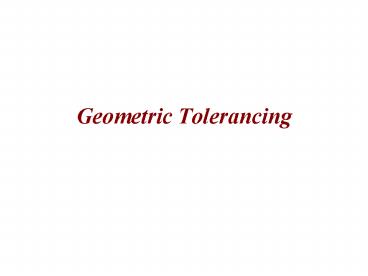Geometric Tolerancing - PowerPoint PPT Presentation
1 / 19
Title: Geometric Tolerancing
1
Geometric Tolerancing
2
Geometric Tolerancing
- Geometric tolerances state the maximum allowable
- variations of a form or its position from the
perfect - geometry implied on the drawing.
- Traditional notes which explain geometric
tolerance - variations have been used in the past.
Presently, - however, it is recommended that such tolerances
be - defined using the geometric characteristic
symbols - outlined in ANSI Y14.5M-1994.
3
Geometric Control Symbols (See Table 10.4)
Key
Symbols of main focus in class
4
Geometric Control Symbols (cont) Orientation Group
- Parallelism, perpendicularity and angularity
- Feature control frame is comprised of three
segments - Tolerance is linear
- Referenced datum plane does not have to be a
principle plane.
The Meaning
5
Geometric Control Symbols (cont) Position Group
- Concentricity
- Used to establish a relationship between the axes
of two or more cylindrical features - The feature control frame is divided into 3
segments - The tolerance specifies a cylindrical tolerance
zone and is, thusly, preceded by the symbol ?
The Meaning
6
Geometric Control Symbols Position Group (cont)
- Symmetry
- Defines a tolerance zone where the median points
of opposite symmetrical - surfaces align with the datum center
plane. - The feature control frame is comprised of 3
segments - The related datum reference is the datum center
plane - The tolerance will always be applied on a RFS
(Regardless of Feature Size) basis
The Meaning
7
Geometric Control Symbols Position Group (cont)
- Positional
- The most important of the geometric control
tolerance symbols. - Controls the location of a cylindrical tolerance
zone where the centerline - of a feature is located.
- Tolerance is applied with a diameter tolerance
zone with relation to its - material condition size.
- The feature control frame is comprised of 5
segments. The last three - segments refer to the primary, secondary, and
tertiary datum reference - planes respectively.
8
The Positional Tolerance Feature Control Frame
Geometric Control Symbol
Diametric or Linear Tolerance
Material Condition Symbol
Primary Datum Reference Plane
Secondary Datum Reference Plane
Tertiary Datum Reference Plane
Maximum Material Condition
Least Material Condition
Material Condition Symbols
Regardless of Feature size
Projected Tolerance
Free State Condition
9
(No Transcript)
10
Meaning of the Positional Tolerance
MMCHole - Position Tolerance Theoretical
Boundary
11
Finding the Applied PositionalTolerance
12
1. Finding the Applied Positional Tolerance at
MMC
For Internal Features Applied Tolerance
Actual size -MMC Positional Tolerance For
External Features Applied Tolerance MMC -
Actual Size Positional Tolerance
13
2. Finding the Applied Positional Tolerance at
LMC
For External Features Applied Tolerance
Actual size -LMC Positional Tolerance For
Internal Features Applied Tolerance LMC -
Actual Size Positional Tolerance
14
3. Finding the Applied Positional Tolerance
Regardless of Feature Size (RFS)
15
Calculating the Numerical Valueof the Positional
Tolerance
16
Three Possible Situations
- 1. Floating Fastener Application
- Where two or more parts are assembled with
fasteners such as nuts and bolts and all parts - have clearance holes.
- When holes in a pattern are the same diameters,
the bolts used are the same diameters, and - the same positional tolerance for all the holes
is to be the same, then the positional tolerance - may be calculated as the allowance (MMCHole -
MMCBolt) applicable for all holes within - the pattern of each part.
Typical Floating Fastener Application
17
- 2. Fixed Fastener Application
- Where one of the parts to be assembled has a
held-in-place fastener - such as a threaded hole for a bolt, screw, or
stud. - Only one of the parts will have clearance around
it, so the positional - tolerance of that one hole is to be shared with
the threaded hole. In this - case, the positional tolerance is distributed
at the discretion of the engineer. - That tolerance usually is 50 of the allowance
with half going to the clearance - hole and the other half going to the threaded
hole.
Typical Fixed Fastener Application
18
- 3. All Other Applications
- A circumscribed circle drawn from the square
defined by dimensional tolerances
19
(.012 .012)1/2 .014































